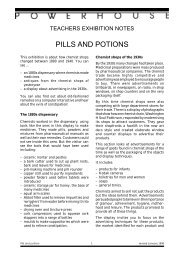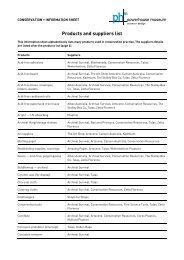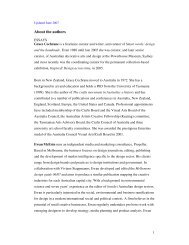Looking after silver - Powerhouse Museum
Looking after silver - Powerhouse Museum
Looking after silver - Powerhouse Museum
You also want an ePaper? Increase the reach of your titles
YUMPU automatically turns print PDFs into web optimized ePapers that Google loves.
CONSERVATION • INFORMATION SHEET<br />
This sheet explains how to clean <strong>silver</strong> and how to<br />
slow down the corrosion process.<br />
Silver components<br />
Silver is a white metal that is quite soft and versatile.<br />
It is too soft to be used in its pure state so it is often<br />
plated onto other metals, almost always with a layer<br />
of copper in between. Sterling <strong>silver</strong> is always 92.5%<br />
<strong>silver</strong> and 7.5% copper alloy. 'Sheffield Plate' is the<br />
earliest form of <strong>silver</strong>-plating, which developed in<br />
England around 1742. This was largely replaced by<br />
electroplated <strong>silver</strong> (EPNS) in the mid 1800s which<br />
used less <strong>silver</strong>. Silver can also be plated with gold,<br />
alloyed with other metals or inlaid with materials<br />
such as gems, wood or ivory. It can be shaped by<br />
hammering, turning or casting into intricate shapes<br />
and it can be engraved. Hallmarks or other stamped<br />
marks underneath a <strong>silver</strong> object will help you<br />
recognise if your object is sterling or <strong>silver</strong>-plated.<br />
Silver damage and how to reduce it<br />
1. Touching <strong>silver</strong><br />
Salts and grease in our skin are highly corrosive to<br />
metal. Fingerprint marks on metal can become<br />
corrosive and are difficult to remove. It is best to<br />
handle metals with clean cotton or disposable vinyl<br />
gloves to stop oils from hands passing onto the metal.<br />
These photos show how the grease and salts from a<br />
person’s fingerprints can react with the <strong>silver</strong> and<br />
become tarnished. If left for a long time, the<br />
fingerprints become etched onto the surface and<br />
are impossible to remove.<br />
<strong>Looking</strong> <strong>after</strong> <strong>silver</strong><br />
2. Rough handling<br />
Silver is a soft metal which can be dented or<br />
damaged when handled roughly. Silver abrades<br />
easily and shouldn’t come in contact with other<br />
materials. It is easy to damage raised areas such as<br />
handles or feet of metal objects. Handles can often<br />
be weaker or more brittle than they appear so it is<br />
advisable not to pick up a <strong>silver</strong> item by the handles.<br />
When moving an item, wear gloves and use two<br />
hands around the body of the object.<br />
3. Tarnish from acids and materials that contain<br />
sulphur compounds<br />
Tarnish is a corrosion process known as black <strong>silver</strong><br />
sulphide. It appears as a gradual discolouration<br />
from yellow or pink, to brown, dark grey then black.<br />
It also causes <strong>silver</strong> to lose its sheen. Tarnish can<br />
also be green if the <strong>silver</strong> is made from a copper/<br />
<strong>silver</strong> alloy.<br />
Many gasses and materials cause <strong>silver</strong> to corrode.<br />
It corrodes when it comes in contact with water<br />
and/or high humidity, dust, acids (commonly from<br />
fingertips), salts, oils and some metal polishes. It<br />
can also be caused by sulphur compounds in the air<br />
(hydrogen sulphide) which are found in car<br />
exhausts, rubber products, cigarette smoke and<br />
other pollutants. Wooden cabinets and wood<br />
products such as plywood, chipboard and custom<br />
wood contain formaldehyde which will cause <strong>silver</strong><br />
to corrode. Protein based materials such as wool,<br />
felt, silk and leather also contain sulphur<br />
compounds that are harmful to <strong>silver</strong>. Acids from<br />
cardboard, paper, plastics such as PVC and<br />
1
polyvinyl acetate and some food (eg mayonnaise,<br />
salt, egg) can also be harmful to <strong>silver</strong>.<br />
This is an example of tarnished, <strong>silver</strong>-plated metal,<br />
caused by gases emitted from formaldehyde which is<br />
used in modern timber storage cabinets.<br />
Salt residue has corroded this <strong>silver</strong> salt container.<br />
4. High humidity<br />
Silver objects on open display or storage shelves will<br />
collect dust from the air. In a damp environment<br />
(over 60%), fine dust will absorb moisture from the<br />
air and will start to corrode the <strong>silver</strong>. Avoid storing<br />
objects in damp storage conditions such as basements.<br />
Increasing ventilation will help reduce humidity or<br />
you can use dehumidifiers or air-conditioning to<br />
limit moisture in the air. Use a soft, clean, lint-free<br />
cloth or a very soft hairbrush to keep <strong>silver</strong> dustfree<br />
and not vulnerable to tarnishing.<br />
This photo shows fingerprints on the body of the jug. The<br />
dust on the lid has absorbed moisture and caused spot<br />
corrosion areas.<br />
5. Abrasive polishes<br />
A lot of <strong>silver</strong> damage happens when people try to<br />
remove tarnish with polishing creams, wadding and<br />
rouge sticks. These products contain abrasive<br />
compounds as well as corrosive hydrochloric or<br />
sulphuric acids. They will remove much more of the<br />
<strong>silver</strong> surface than a <strong>silver</strong> cloth or <strong>silver</strong> dip will.<br />
Over time and with repeated cleaning, they will<br />
leave fine scratches on the surface, will wear away<br />
the <strong>silver</strong> and can diminish engraved decorations or<br />
inscriptions. Over-polishing plated <strong>silver</strong> will actually<br />
remove the <strong>silver</strong>-plating which will expose dull<br />
areas of base metal that can be mistaken for<br />
tarnish. It is also advisable not to use brass or<br />
chrome cleaners on <strong>silver</strong>. Harsh chemicals and<br />
abrasives needed for cleaning copper or brass will<br />
damage <strong>silver</strong>. Do not consider using<br />
electrochemical cleaners either as they deposit a<br />
layer of another metal on top of the original<br />
surface, which will then be irretrievably lost.<br />
The green, crusty corrosion on the <strong>silver</strong> coffee jug has<br />
been caused by <strong>silver</strong> dip not being removed properly. The<br />
<strong>silver</strong> dip soaks into the crevices and causes continuous<br />
corrosion. Polish residue in crevices hardens over time<br />
and becomes difficult to remove.<br />
6. Coatings<br />
Coating <strong>silver</strong> objects to prevent tarnishing is not<br />
encouraged. Contact a metal conservator if you are<br />
thinking of taking this option.<br />
7. Poor storage materials<br />
Because of the sulphurous content of many storage<br />
materials, it is advisable to store metal objects in<br />
an environment that is free of dust, is well<br />
ventilated and dry.<br />
Recommended storage materials for <strong>silver</strong><br />
• Use sulphur absorbing materials such as activated<br />
charcoal cloths or <strong>silver</strong> impregnated cotton bags<br />
to slow down tarnishing in storage areas.<br />
• Use stable materials such as washed cotton or<br />
linen cloths or old sheeting to wrap your <strong>silver</strong> in<br />
or put large objects under cotton dust covers.<br />
2
• Small <strong>silver</strong> can be wrapped in acid-free tissue<br />
and placed in polyethylene (ziplock) bags.<br />
• Metal shelving and cabinets are preferable to<br />
wooden shelving.<br />
• Internal wooden shelving and cabinets should be<br />
sealed with good quality water based paint (leave<br />
enough time for paint to dry and off-gas<br />
thoroughly) to stop harmful emissions, such as<br />
formaldehyde being released from the wood. The<br />
internationally recognised time for off-gassing of<br />
volatile organic compounds (VOCs) is three<br />
weeks.<br />
• An alternative way of sealing wood is to use a<br />
barrier foil (cover edges).<br />
• Use moisture absorbing materials to buffer<br />
humidity changes, such as: acid-free tissue<br />
paper, acid-free boxes or washed, natural<br />
fabrics.<br />
Recommended display materials for <strong>silver</strong><br />
• If possible, use metal showcases with stable<br />
coatings such as powder coated enamel.<br />
• If using wood, seal it with good quality water<br />
based paint, leave three weeks for paint to dry<br />
and off-gas thoroughly).<br />
• Another method to stop wood from off-gassing is<br />
to place a barrier over it such as foil or mylar<br />
before covering it with a display fabric.<br />
• Use washed, undyed or colour-fast, natural fibre<br />
fabrics such as cotton and linen to line the<br />
display boards. Do not use wool or felt as they<br />
contain harmful sulphur compounds.<br />
• Use moisture absorbing materials to buffer<br />
humidity fluctuations in the display case, such as<br />
acid-free mount board or natural fabrics.<br />
• Use sulphur absorbing materials, such as<br />
activated charcoal cloths in display cases.<br />
Unlike the body of this jug, the bottom rim has not been<br />
affected by atmospheric pollutants and fingerprint<br />
greases and salts. This shows it has not been displayed<br />
or stored in a good environment.<br />
Once they have been cleaned, <strong>silver</strong> objects can be placed<br />
in <strong>silver</strong> impregnated cloth, ziplock or freezer bags for<br />
storage.<br />
Activated charcoal cloths absorb atmospheric pollutants<br />
and improve the environment inside storage or display<br />
spaces. The top right sample is a <strong>silver</strong> impregnated<br />
cloth, the rest are activated charcoal cloths.<br />
How to clean <strong>silver</strong><br />
Decide which <strong>silver</strong> items in your collection are<br />
valuable — historically, personally, financially. It is<br />
best to have the valuable items treated by a metals<br />
conservator. In general, it is not a good idea to<br />
routinely polish or aggressively clean metal pieces.<br />
Tarnish (<strong>silver</strong> sulphide) contains <strong>silver</strong>, so every<br />
time it is cleaned a small amount of <strong>silver</strong> metal is<br />
removed along with the tarnish. For your everyday<br />
<strong>silver</strong> items, it is best to keep tarnish removal to a<br />
minimum and only use the most mild and nonabrasive<br />
methods for cleaning <strong>silver</strong>.<br />
It is a good idea to make notes and take photos that<br />
show what materials and method you used to clean<br />
your <strong>silver</strong>.<br />
3
Supplies<br />
• Cotton gloves (washed) and/or disposable, vinyl<br />
gloves (preferably powder-free) — chemists<br />
• Silver cloths impregnated with tarnish inhibitor<br />
and <strong>silver</strong> foam (available from jewellers or<br />
supermarkets, note: they cannot be washed and<br />
reused)<br />
• Washed, clean cotton cloths (old sheets)<br />
• Clean water and mild detergent, such as<br />
Sunlight soap<br />
• Cotton buds — chemists<br />
• Methylated spirits — supermarkets<br />
• Activated charcoal cloth — Zetta Florence,<br />
Archival Survival, eBay<br />
• Ziplock plastic bags or high density polyethylene<br />
bags — supermarkets, plastic suppliers,<br />
conservation suppliers<br />
• Satay sticks — supermarkets<br />
Please refer to the ‘Products and suppliers’<br />
information sheet for further details.<br />
1. Cleaning light to medium tarnish removal (for<br />
<strong>silver</strong> that is used regularly)<br />
Use this method when you see the surface of your<br />
<strong>silver</strong> objects looking dull or yellowish.<br />
Wash with a mild detergent such as Sunlight soap in<br />
warm, clean water.<br />
Rinse in clean water and dry with a cotton cloth<br />
Wipe with a clean <strong>silver</strong> cloth (impregnated with tarnish<br />
inhibitors) to give a preventive coating to your object.<br />
Ensure both dust and grease are removed before buffing<br />
with <strong>silver</strong> cloth as they could scratch the surface.<br />
2. Cleaning light tarnish removal on composite<br />
<strong>silver</strong> (<strong>silver</strong> which has bone, ivory, bakelite,<br />
wooden handles or other attachments)<br />
When light tarnish removal is required, it is<br />
advisable not to immerse composite <strong>silver</strong> objects<br />
in water as they are sensitive to moisture and may<br />
discolour or deteriorate. Use cotton buds dipped in<br />
methylated spirits to degrease the <strong>silver</strong>. Wipe with<br />
a <strong>silver</strong> impregnated cloth.<br />
These photos show examples of composite <strong>silver</strong> objects<br />
— a bakelite and <strong>silver</strong> tea set and an ivory and <strong>silver</strong><br />
knife set.<br />
4
3. Cleaning heavy tarnish removal (decorated<br />
surfaces may need to be cleaned with a <strong>silver</strong> dip)<br />
Dampen a washed, soft cotton cloth.<br />
Silver foam contains very fine abrasives, mild soap and<br />
chemicals that help remove tarnish. Dip the damp cloth<br />
in <strong>silver</strong> foam.<br />
Rub the <strong>silver</strong> foam onto the surface of the <strong>silver</strong> with<br />
cloth.<br />
The <strong>silver</strong> foam can be applied to smaller areas and<br />
crevices with a soft brush. Cut the bristles to make the<br />
brush stiffer. Put a piece of masking tape around the steel<br />
collar of the brush to prevent it scratching the <strong>silver</strong><br />
during this process.<br />
Ensure all the foam and polish residue has been removed<br />
from the crevices in your <strong>silver</strong>. Use a soft brush if<br />
needed. Hardened polish residue can be softened with<br />
methylated spirits and a satay stick.<br />
Dry with a clean cotton cloth.<br />
5
Wipe with a clean <strong>silver</strong> polishing cloth.<br />
This information sheet is part of a series developed by <strong>Powerhouse</strong> <strong>Museum</strong> Conservation department, October 2010.<br />
500 Harris St Ultimo Sydney + PO Box K346 Haymarket NSW 1238 + www.powerhousemuseum.com<br />
Telephone (02) 9217 0273 + Facsimile (02) 9217 0498 + Email katec@phm.gov.au<br />
The <strong>Powerhouse</strong> <strong>Museum</strong>, part of the <strong>Museum</strong> of Applied Arts and Sciences also incorporating Sydney Observatory, the <strong>Powerhouse</strong> Discovery Centre and the<br />
NSW Migration Heritage Centre, is a NSW government cultural institution. © 2010 Trustees of the <strong>Museum</strong> of Applied Arts and Sciences<br />
6
















